 |
 |
 |
| |
Minority species resistance (Ultra-Deep Sequencing) present at screening does not affect outcomes at Week 48 in lersivirine (UK-453,061) Phase 2b study A5271015 in treatment-naïve patients
|
| |
| |
Reported by Jules Levin
6th International AIDS Society Conference on HIV Pathogenesis, Treatment and Prevention, July 17-20, 2011, Rome, Italy
C Craig,1 C Wang,2 N Cusack,2 J Mori,1 B Taillon,3 M Westby,1 M Tawadrous2
1Pfizer Global Research and Development, Sandwich, Kent, UK; 2Pfizer Inc., Groton, CT, USA; 3454 Life Sciences, A Roche Company, Branford, CT, USA
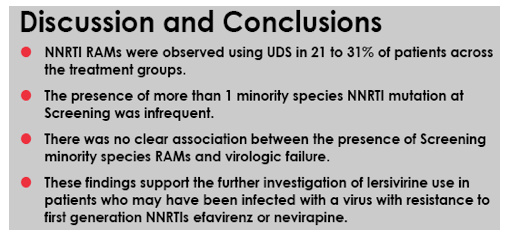
"Week 48 response was observed with LRV in patients with minority species K103N.....Among the LRV treated patients, ≥1 minority LRV RAM was detected in virus from nine patients (8%) (three received LRV 500 mg and six received LRV 750 mg); eight of the nine responded to therapy through Week 48. In the remaining patient (K101E/F227L), the viral load response over time was consistent with poor adherence. Patients in the EFV treated group with minority LRV RAMs at Screening (N=10) were not associated with virologic failure. The EFV RAM, K103N, was observed in three subjects at Screening; all were treated with LRV and responded to therapy."
ABSTRACT
Background: Lersivirine (LRV, UK-453,061) is an NNRTI with a unique resistance profile. Study A5271015 is a 96-week, international, double-blind, randomized, Phase 2b study in HIV-1-infected, treatment-naïve patients, to assess the antiviral activity and safety of LRV (500/750 mg once daily [QD]) or efavirenz (EFV, 600 mg QD), each combined with tenofovir DF/emtricitabine (300 mg/200 mg QD). Minority species NNRTI resistance is a clinically significant problem in treatment-naïve HIV-1-infected persons. The objective of this analysis was to assess the impact of minority species resistance-associated mutations (RAMs) on response through Week 48.
Methods: Ultra-deep sequencing was performed successfully on 179/193
Screening samples across all treatment groups. Association between IAS USA or LRV minority RAMs (i.e. present in >1% to <20% of sequences) and virologic outcome at Week 48 was examined. Mutations observed using population genotyping were excluded.
Results
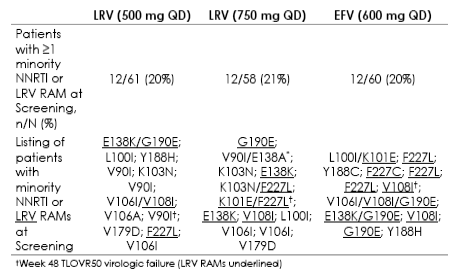
Among the LRV treated patients, ≥1 minority LRV RAM was detected in virus from nine patients (8%) (three received LRV 500 mg and six received LRV 750 mg); eight of the nine responded to therapy through Week 48. In the remaining patient (K101E/F227L), the viral load response over time was consistent with poor adherence. Patients in the EFV treated group with minority LRV RAMs at Screening (N=10) were not associated with virologic failure. The EFV RAM, K103N, was observed in three subjects at Screening; all were treated with LRV and responded to therapy.
Conclusions: The prevalence of LRV minority species RAMs was low and not associated with failure. Week 48 response was observed with LRV in patients with minority species K103N.
Introduction
The presence of low-frequency (minority) resistance-associated mutations
(RAMs) has been associated with a poor response to antiretroviral therapy.1,2
Non-nucleoside reverse transcriptase inhibitors (NNRTIs) are used widely in anti-HIV-1 regimens and are generally effective in treatment-naïve patients. However, increased risk of virologic failure has been associated most strongly with NNRTI-resistant minority species (hazard ratio 2.6; 95% CI 1.9, 3.5).2
Lersivirine (UK-453,061) was developed as a next-generation NNRTI, in part incorporating the retention of antiviral activity against the most common first generation NNRTI RAMs (e.g. K103N, Y181C, and G190A). The result is an NNRTI with a unique resistance profile.
Study A5271015 is an on-going 96-week, Phase 2b study in HIV-1-infected, treatment-naïve patients, to assess the antiviral activity and safety of lersivirine compared with efavirenz, each in combination with tenofovir
DF/emtricitabine.
The objective of this analysis was to assess the impact of minority species
RAMs on response at Week 48.
Methods
Study Design
This 96-week, international, double-blind, randomized, Phase 2b study
included HIV-1- infected, treatment-naïve patients. Additional selection
criteria were: HIV-1 RNA ≥1000 copies/mL; CD4+ >200 cells/mm3; and no
reverse transcriptase (RT) mutations by standard genotyping.
Patients were randomized to receive lersivirine (500 mg once daily [QD]),
lersivirine (750 mg QD), or efavirenz (600 mg QD), each in combination with tenofovir DF/emtricitabine (300 mg/200 mg QD) (Figure 1).
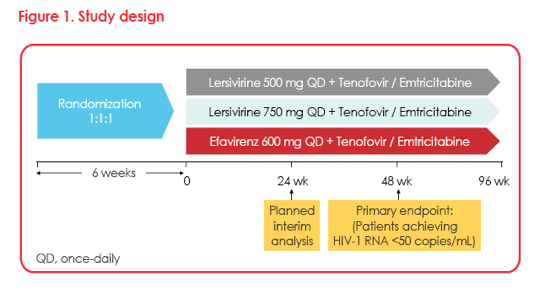
The clinical endpoints and Week 48 findings from this study are presented
elsewhere at this meeting (Abstract TUAB0101).3
Ultra-Deep Sequencing
· Ultra-deep pyro-sequencing (UDS) was performed at 454 Life Sciences (Roche Applied Sciences, Indianapolis, IN, USA). Approximately 30,000 beads per sample were prepared for UDS. Sequencing was performed using a Genome Sequencer FLX. Amplicon Variant Analyzer software was used to align all amplicon sequence reads to a consensus sequence. The analysis was performed such that approximately 1,000 sequences were obtained per sample. Amino acid variants present at >1% were included in the analysis.
· Screening samples from all eligible patients (plasma HIV-1 RNA ≥2000 copies/mL at Screening) enrolled in Study A5271015 were assessed for amino acid variants associated with resistance to NNRTI or nucleoside reverse transcriptase inhibitor (NRTI) present in the viral quasi-species. In the initial analysis (as presented in the abstract), those mutations present with a prevalence >1% to <20% of sequences were included; RAMs observed using population genotyping (Mongram Biosciences, South San Francisco, CA,
USA) were excluded. In the present analysis, all detectable mutations with prevalence >1% were included for completeness. Mutations from the IAS USA resistance tables4,5 were included (apart from T69ins).
· IAS USA NNRTI RAMs of interest included: V90I, A98G, L100I, K101E, K101H, K101P, K103N, V106A, V106I, V106M, V108I, E138A, V179D, V179F, V179T, Y181C, Y181I, Y181V, Y188C, Y188H, Y188L, G190A, G190S, P225H, M230L, and P236L.
· Our provisional list of mutations that have been associated with the
development of resistance to lersivirine in vitro or during extended testing of NNRTI-mutant viruses included: K101E, V108I, E138K, Y188L, G190E, G190Q, H221Y, F227C, F227L, M230I, and L234I.
· IAS USA mutations reported for efavirenz included: L100I, K101P, K103N, V106M, V108I, Y181C, Y181I, Y188L, G190A, G190S, and P225H.
· IAS USA NRTI RAMs included: M41L, A62V, K65R, D67N, K70E, K70R, L74V, V75I, F77L, Y115F, F116Y, Q151M, M184I, M184V, L210W, T215F, T215Y, K219E, and K219Q.
· The presence of NNRTI and lersivirine RAMs detected at Screening using UDS was correlated with the Week 48 outcomes. The presence of RAMs detected using population genotyping (>20% prevalence) is also indicated.
Loss of Virologic Response
All treated patients were assessed for response using the TLOVR50 algorithm.
RESULTS
Table 1 summarizes the proportion of treated patients with Screening samples analyzed using UDS.
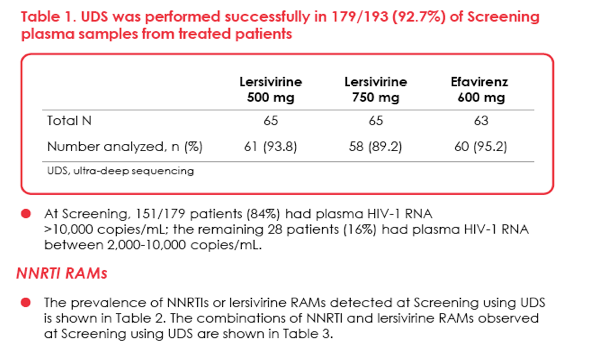
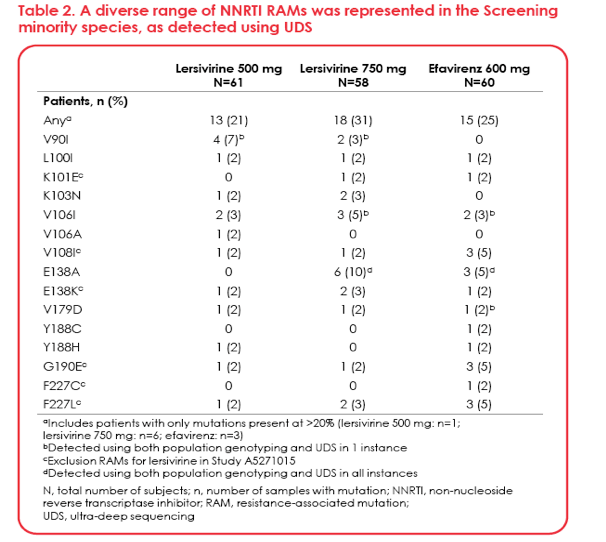
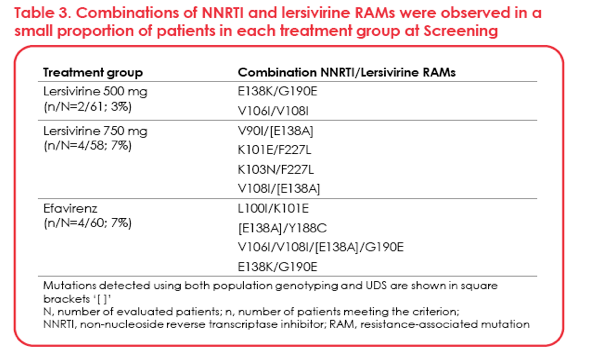
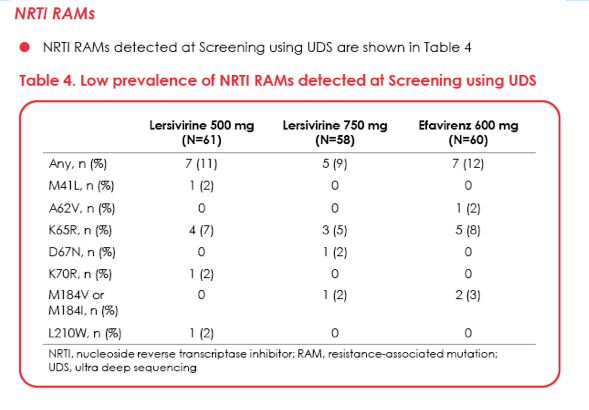
· All of the NRTI RAMs shown in Table 4 were detected using UDS only with prevalences <20% and so were considered to be minority species.
· Overall, the incidence of patients infected with virus encoding NRTI RAMs observed at Screening using UDS was low, even when detection was measured down to 1% prevalence. However, there was a notable, relatively high prevalence of K65R (all associated with Clade C infections, data not shown), although detection of this or M184V/I using population genotyping were considered exclusion criteria at Screening.
· Selection of K65R in Clade C infections has been recognized as a frequent occurrence6 as the RT residue 65 is situated in a mutagenesis 'hot spot'.7,8 The clinical significance has not been established.
· Virus from 1 patient treated with EFV was found to harbor minority K65R and M184I. Our analysis could not differentiate if these mutations were encoded together within a single viral RNA.
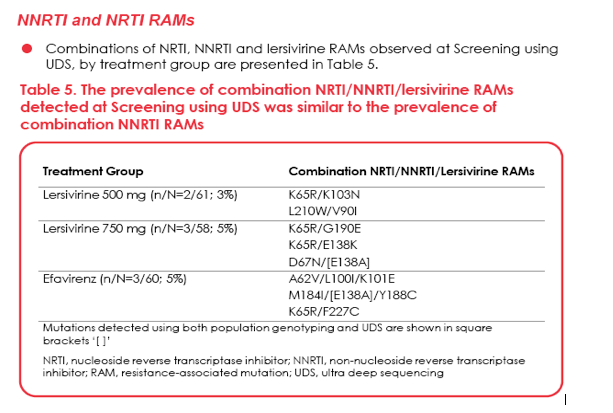
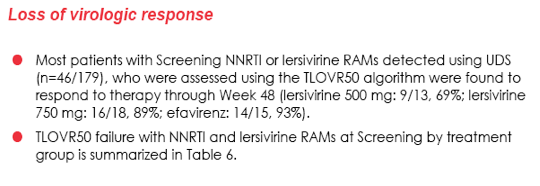
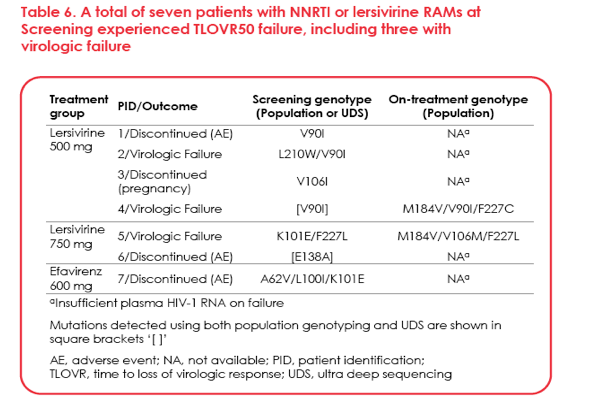
· On-treatment genotypes were available for two patients using population genotyping.
· In one of the two instances where genotype was available, the minor etravirine RAM, V90I, present at a frequency of 96% in the patient's viral population, was also observed on-treatment in combination with M184V, providing resistance to the emtricitabine background, and the lersivirine RAM, F227C (subject 4), neither of which was detected at Screening.
· In the other patient (subject 5), K101E and F227L were both present at Screening (1.32 and 1.11%, respectively). Only the F227L was observed on-treatment, when additional mutations, M184V and V106M, were detected.
References
1. Johnson JA, et al. PLoS ONE 2007; 2: e638.
2. Li JZ, et al. JAMA 2011; 305: 1327-1335.
3. Vernazza P, et al. Presented at the 6th International AIDS Conference on HIV
Pathogenesis, Treatment and Prevention, Rome, Italy, 17-20 July, 2011; abs 3950.
4. Johnson VA, et al. Top HIV Med 2009; 17: 138-145.
5. Johnson VA, et al. Top HIV Med 2006; 14: 125-130.
6. Li JF, et al. J Infect Dis 2011; 203: 798-802.
7. Coutsinos D, et al. J Virol 2009; 83: 2029-2033.
8. Coutsinos D, et al. Antivir Chem Chemother 2010; 20: 117-131.
|
| |
|
 |
 |
|
|